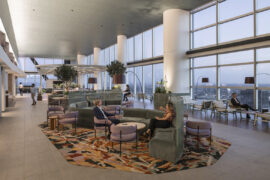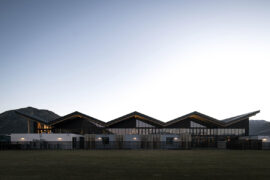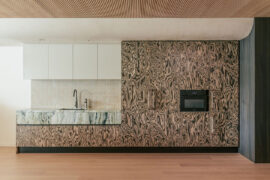Jakob Factory Saigon by Rollimarchini Architekten and G8A Architects proposes a new factory typology with emphasis on the wellbeing of people and planet.

June 30th, 2021
For almost two decades now, Ho Chi Minh City has been one of Vietnam’s shining trophies of progress, developing at breakneck speed and attracting droves of people into the city. Like a magnet pulling everything towards itself, Vietnam’s economic capital has also drawn the industrial parks, because of the infrastructure and transportation network it affords them. Thanks to the indiscriminate settlement of factories on the land, a belt of barren, non-porous ground sits on the outskirts of Ho Chi Minh City. The environmental consequences are detrimental, particularly for a heat-laden city prone to flooding. It is against this backdrop that Jakob Factory Saigon presents an alternative.

Roofs with deep overhangs echo the traditional tropical architecture that the design team saw in the countryside on their research trip.
Jakob Rope Systems is a Swiss manufacturer of stainless steel cables and wire mesh for architectural applications with part of its production facilities located in Vietnam. Its latest factory is the result of a design partnership between Swiss-based Rollimarchini Architekten (Rollimarchini) and Swiss-born G8A Architects (G8A), the latter having had an office in Vietnam for 15 years now. The facility sits on a 30,000-square-metre plot in the centre of an industrial park in Binh Duong, 50 kilometres north of Ho Chi Minh City, and has been designed with an eye towards environmental and social sustainability.
An initial research trip to the Mekong area with the client revealed a slew of factories that were built with only economic gain in mind – single-storey enclosed boxes that conveniently ignore the tropical climate. “[In these factories] you need air conditioning for ventilation, and you don’t have a lot of natural light inside. It’s not a pleasant place to work in,” says Francesco Marchini, founding partner of Rollimarchini. Put plainly, the smells and fumes within such factories make them unhealthy to be in.

The generous ground-to-building ratio of Jakob Factory Saigon breaks the mould in a sector where single-storey factories usually swallow entire plots.
Instead of following in the footsteps of high-tech precedents, the design team swung to the other extreme and sought to create the first factory in Vietnam with naturally ventilated manufacturing halls. The open and airy traditional architecture they encountered in the countryside became the catalyst for their low-tech approach to Jakob Factory Saigon.
The factory is expressed as an assemblage of two- to three- storey-high blocks around a central courtyard – an allusion to how Vietnamese villages are typically organised and a departure from single-storey factories that usually dominate the entire site. “The client was open to keeping some kind of true-ground condition which would help to cool the space and also give the local ground a chance to survive,” says Manuel Der Hagopian, partner at G8A. In the same breath, the green space offers moments of reprieve and leisure for the workers. As Marchini puts it, “The factory is not just a place to work but a place to be.”

Planters are held in place by a web of steel cables that simultaneously showcases the potential of Jakob Rope Systems’ products.
The unusually tall proportion of the factory meant that much rested on the façade. While it needed to be porous enough to allow daylight and air through, it also had to provide shade and rain protection. A skin of lush plantings ticked all the boxes and then some.
Sandwiching each block, the green façade is the factory’s multi- tasking protagonist that not only mediates the sun and rain, but also purifies the air and helps lower the atmospheric temperature through evaporation. Deep planters made of malleable geotextile are stacked to span the height of the factory. Holding them in place is a suspended structure that hangs off a large mesh-like formation of steel cables – an adept showcase of the client’s product.

Circling the edge of each block is a corridor that buffers the internal spaces of the factory from heavy rain.
The façade is not an impenetrable defense against the region’s typically heavy tropical rain; neither was it expected to function that way. A corridor mediates between the skin and the halls of the factory. It traces the edge of each block and is a social thoroughfare. Equally important is its role as a buffer to accommodate rain that slips past the façade. Only in extreme conditions, like a typhoon, is a second skin of polycarbonate sliding doors activated.
“On most rainy days, a third of the corridor gets wet. Maybe once or twice a year, the entire corridor is wet. It’s something the client was aware of and accepted,” says Der Hagopian. “It’s a give-and-take with nature and the existing conditions. The building does not rule the place.”

Admittedly, Rollimarchini and G8A’s proposal for Jakob Factory Saigon was not always met with enthusiasm. “For the local management, it was difficult for them to imagine a factory without air-conditioning,” says Marchini, sharing how they first saw it as a form of regression. Now that the factory is in use, however, workers have no complaints. More than that, the experience of factory work has drastically improved for them. As for the management? They have the pleasure of reporting a 50 per cent reduction in energy consumption as compared to their other facility in Vietnam.
“This is one out of a thousand factories in the area and it’s not going to change the condition of the area,” Der Hagopian admits. “But it was a way for our client to impact production practices and the way people work, and it’s a prototype of how we can accommodate the challenges of building here.”
Jakob Factory Saigon is among the shortlisted projects for The Building in the 2021 INDE.Awards

INDESIGN is on instagram
Follow @indesignlive
Join our collection to add your product.
Keep up to date with the latest and greatest from our industry BFF's!

For a closer look behind the creative process, watch this video interview with Sebastian Nash, where he explores the making of King Living’s textile range – from fibre choices to design intent.

Merging two hotel identities in one landmark development, Hotel Indigo and Holiday Inn Little Collins capture the spirit of Melbourne through Buchan’s narrative-driven design – elevated by GROHE’s signature craftsmanship.

In an industry where design intent is often diluted by value management and procurement pressures, Klaro Industrial Design positions manufacturing as a creative ally – allowing commercial interior designers to deliver unique pieces aligned to the project’s original vision.

Designed by Woods Bagot, the new fit-out of a major resources company transforms 40,000-square-metres across 19 levels into interconnected villages that celebrate Western Australia’s diverse terrain.

In the New Year, architecture will be defined by its ability to orchestrate relationships between inside and outside, public and private, humans and ecology, and data and intuition.
The internet never sleeps! Here's the stuff you might have missed

Warren and Mahoney’s The Mill in Queenstown blends architecture, wellbeing and landscape, creating a transparent training facility.

Trust sits at the core of Everton Buildings’ new office, where Ambit Curator was given licence to move beyond convention and deliver a workplace defined by vision, materiality and assured detail.

Merging two hotel identities in one landmark development, Hotel Indigo and Holiday Inn Little Collins capture the spirit of Melbourne through Buchan’s narrative-driven design – elevated by GROHE’s signature craftsmanship.